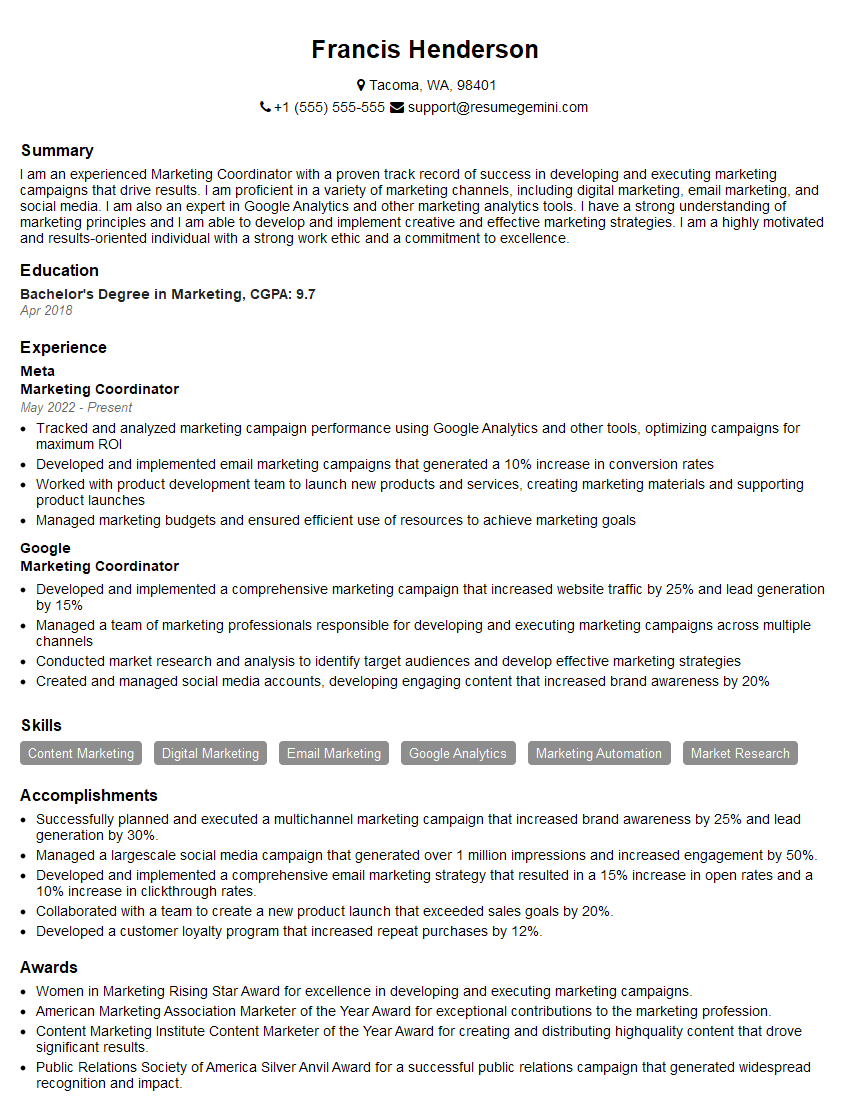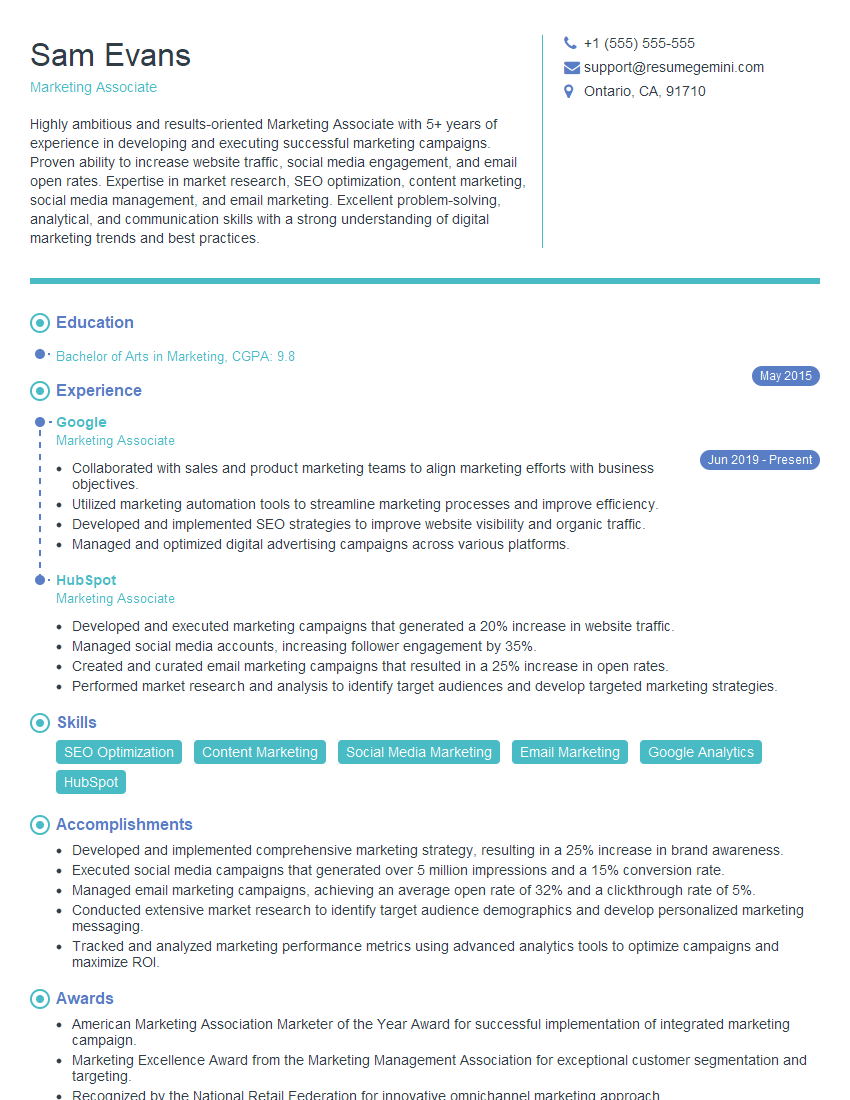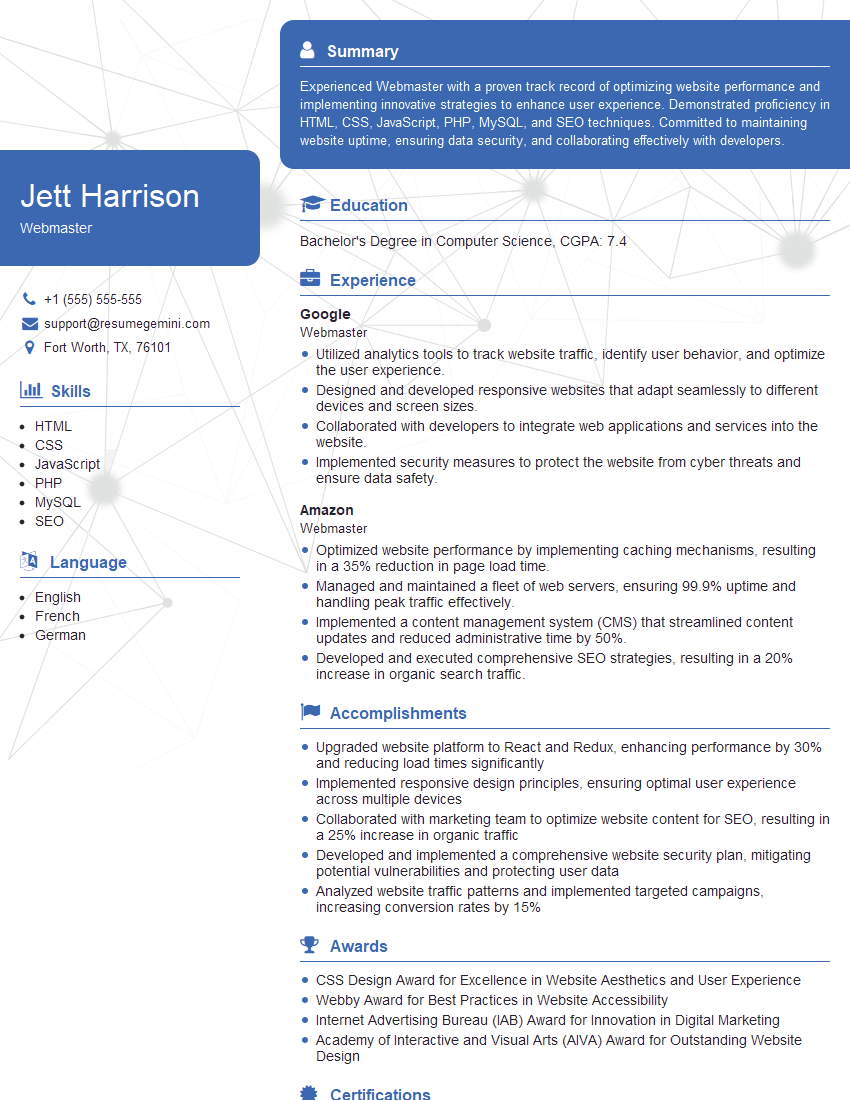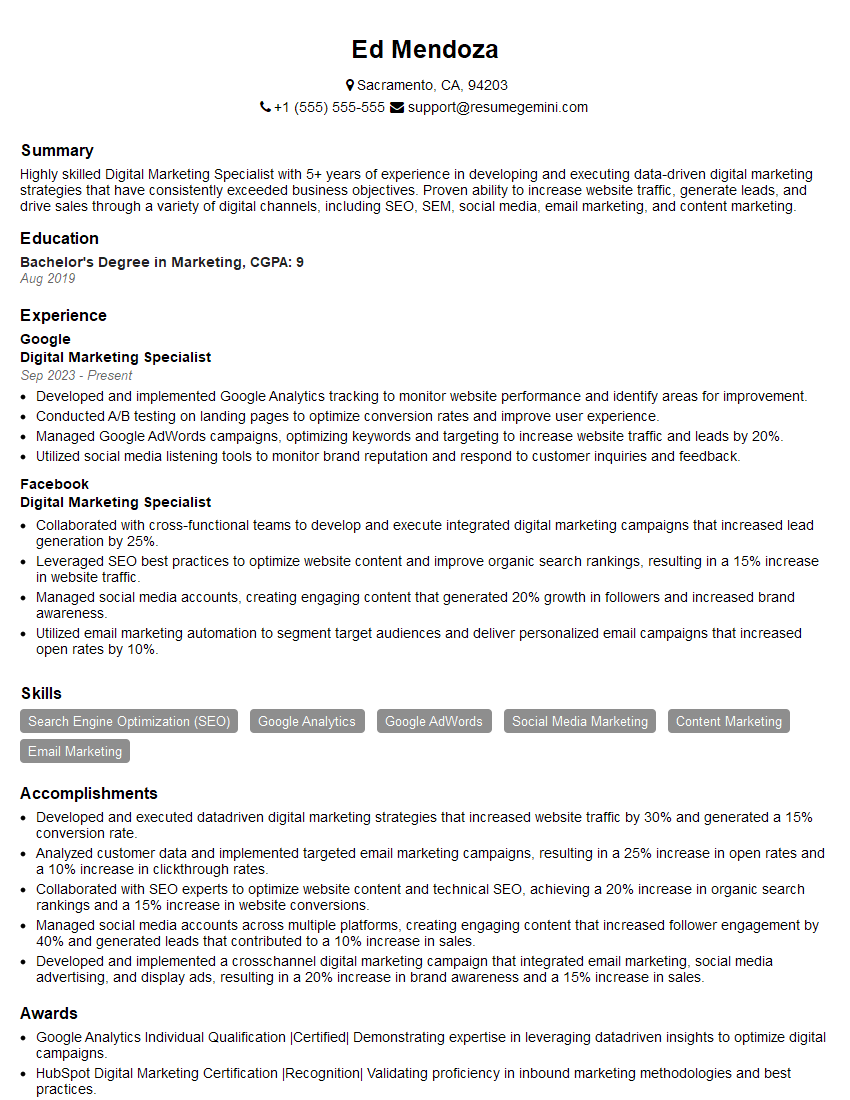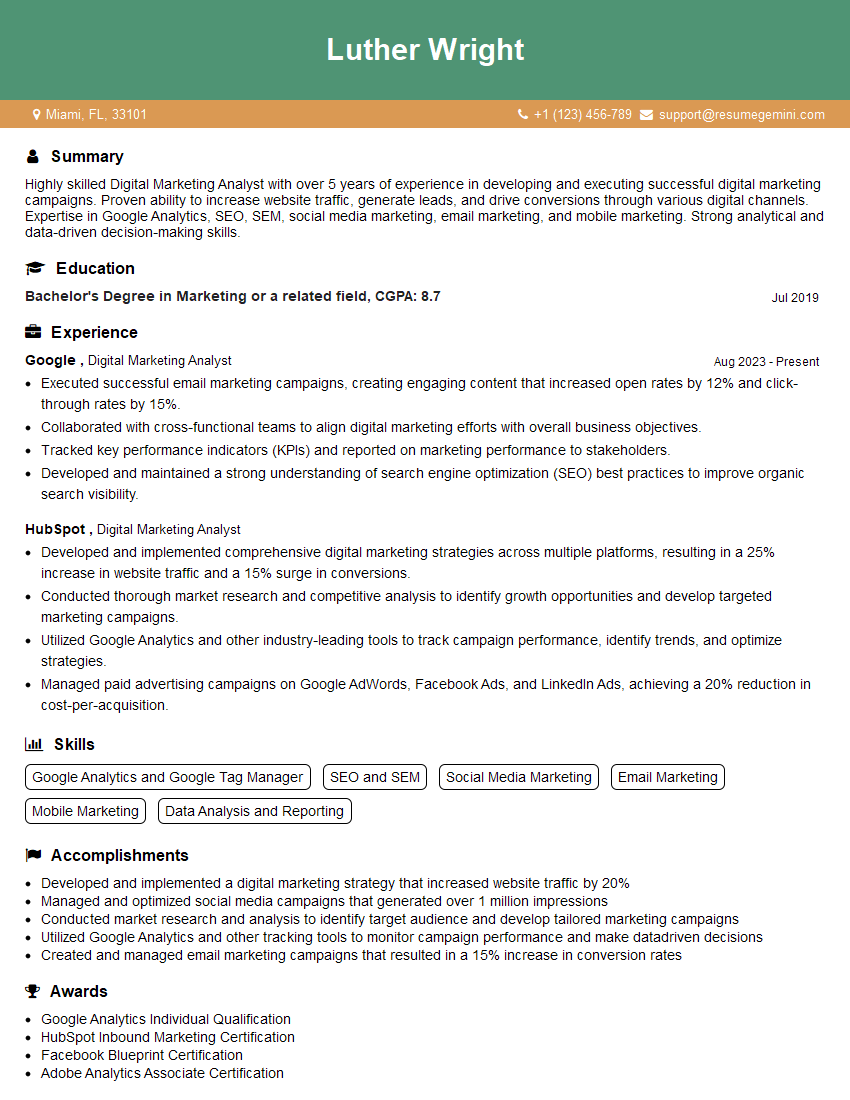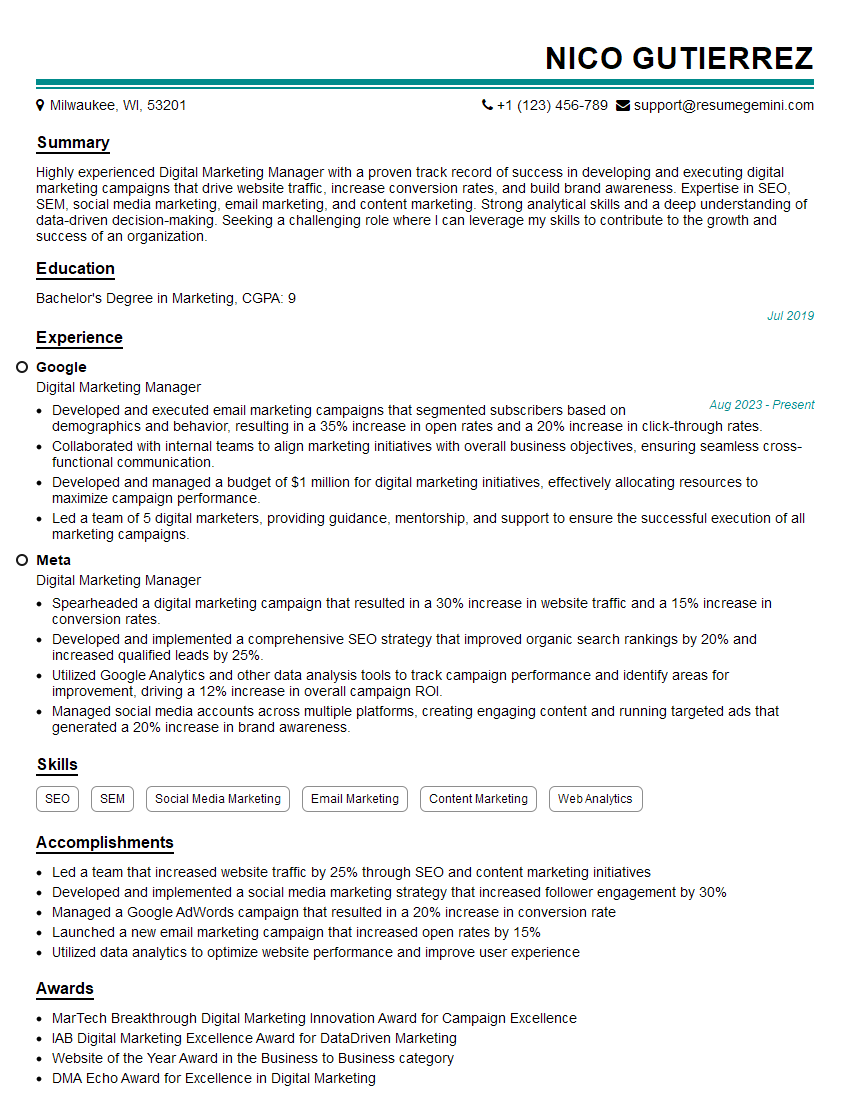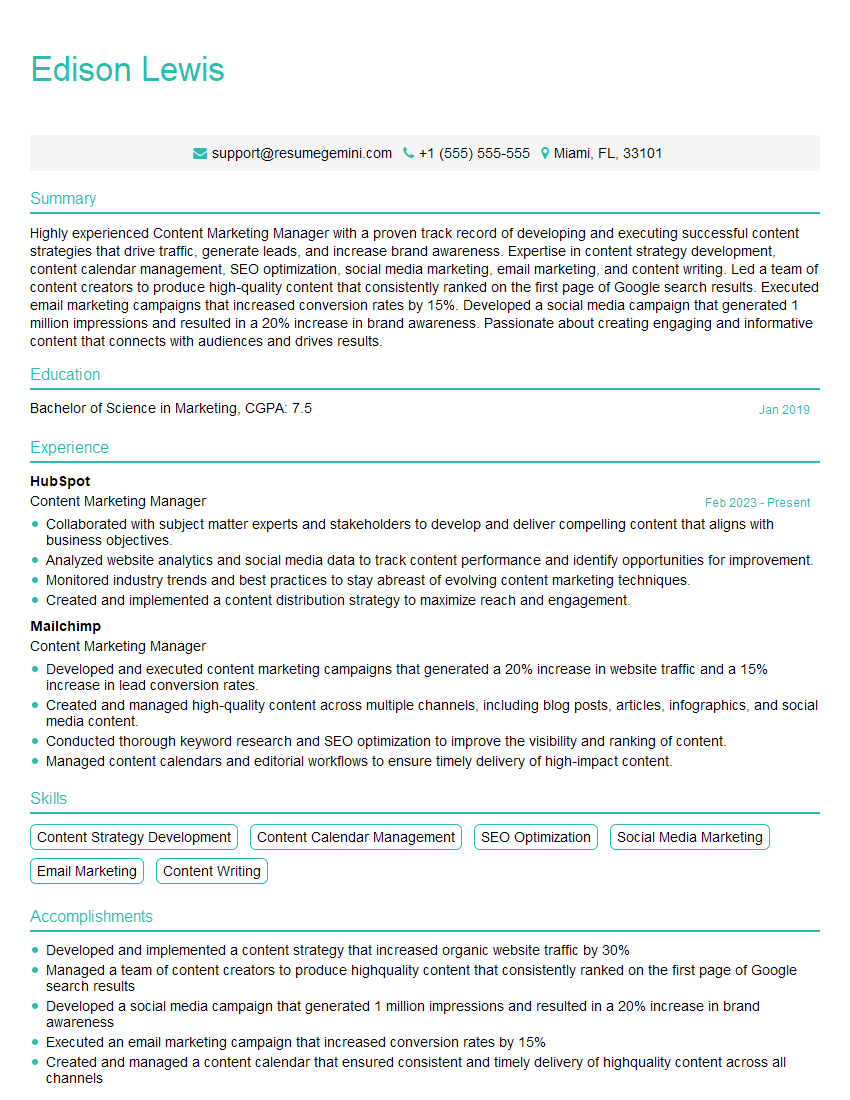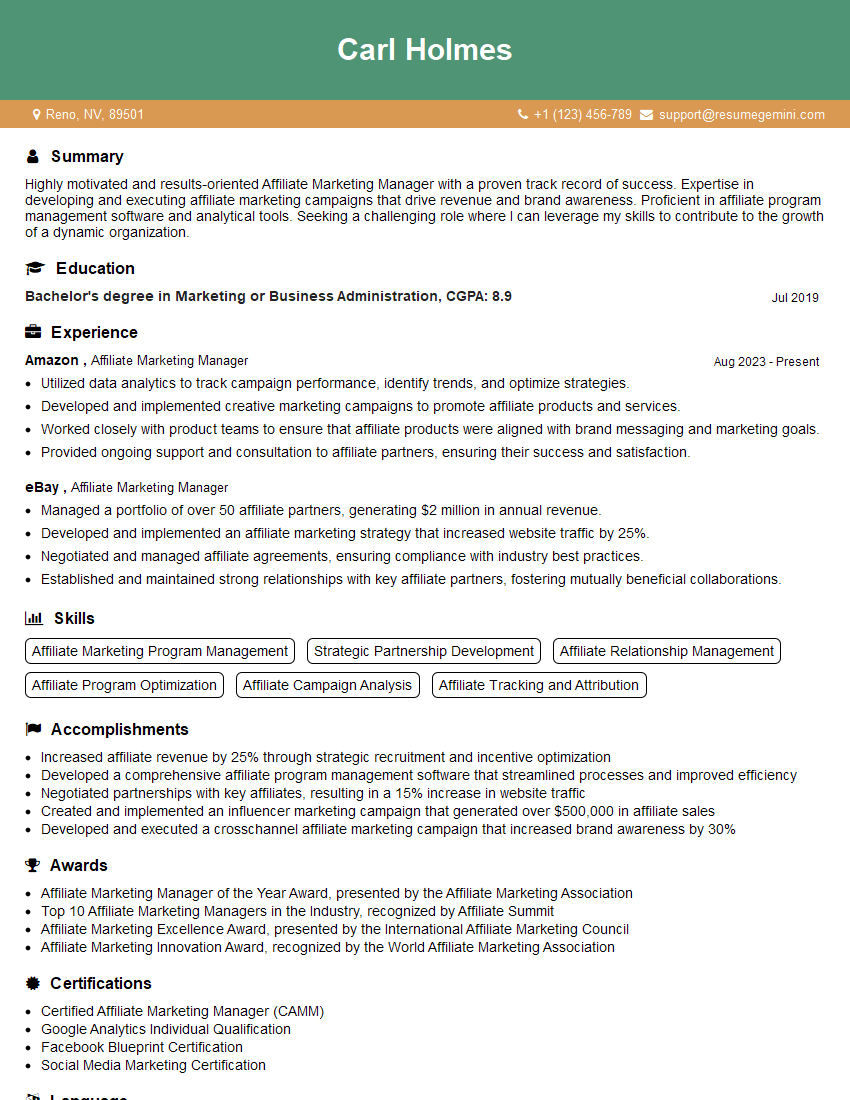Preparation is the key to success in any interview. In this post, we’ll explore crucial Understanding of SEO and digital marketing principles interview questions and equip you with strategies to craft impactful answers. Whether you’re a beginner or a pro, these tips will elevate your preparation.
Questions Asked in Understanding of SEO and digital marketing principles Interview
Q 1. Explain the difference between on-page and off-page SEO.
On-page and off-page SEO are two sides of the same coin, both crucial for improving your website’s search engine ranking. Think of it like building a house: on-page SEO is working on the interior – making sure the rooms are well-designed and functional; off-page SEO focuses on the exterior and neighborhood – building reputation and attracting visitors.
On-page SEO refers to all the optimization techniques you perform directly on your website. This includes optimizing your content (using relevant keywords, ensuring readability, and creating high-quality content), improving your website’s structure (using internal links, creating a clear sitemap), and ensuring fast loading speeds. For example, using header tags (, , etc.) to structure your content and strategically placing keywords throughout your text are key aspects of on-page optimization.
Off-page SEO involves activities performed outside your website to improve your search engine rankings. The primary focus here is link building – earning high-quality backlinks from reputable websites. Other off-page strategies include social media marketing, brand building, and online reputation management. Think of a positive review on Yelp – that’s a form of off-page SEO because it’s not directly on your website, but it impacts your online presence and perceived authority.
Q 2. What are the key ranking factors in Google’s algorithm?
Google’s algorithm is incredibly complex and constantly evolving, but some key ranking factors consistently prove their importance. It’s not about any single factor, but rather a complex interplay of many signals.
- Content Quality and Relevance: Google prioritizes high-quality, original, and relevant content that satisfies user search intent. Think informative, engaging, and well-written articles or valuable resources, not thin or spammy content.
- Technical SEO: This includes website speed, mobile-friendliness, security (HTTPS), and proper site structure. A slow, insecure website will significantly hurt your ranking.
- Backlinks: High-quality backlinks from authoritative websites are a strong indicator of trustworthiness and relevance. Think of them as votes of confidence from other websites.
- User Experience (UX): Factors like bounce rate, time on site, and click-through rate (CTR) all signal how users interact with your website. A poor user experience suggests low-quality content or a poorly designed site.
- Keyword Optimization: Using relevant keywords naturally within your content, meta descriptions, and title tags helps Google understand what your page is about.
- Mobile-Friendliness: With the increasing number of mobile searches, Google prioritizes websites that offer a seamless mobile experience.
It’s crucial to remember that Google’s algorithm is a black box, and the exact weighting of these factors is unknown. The focus should be on creating a high-quality website that provides value to users and follows best practices.
Q 3. How do you perform keyword research?
Keyword research is the foundation of any successful SEO campaign. It’s about identifying the terms and phrases people use when searching for information related to your business or website. Think of it as understanding your customer’s language.
My keyword research process typically involves these steps:
- Brainstorming: I start by brainstorming relevant keywords related to my client’s business, products, or services.
- Using Keyword Research Tools: I leverage tools like SEMrush, Ahrefs, or Google Keyword Planner to expand my initial list, analyzing search volume, competition, and related keywords. This helps identify high-potential keywords with lower competition.
- Analyzing Search Intent: Understanding the intent behind a search query is vital. Are users looking for information, to buy a product, or something else? Tailoring your content to match this intent is crucial.
- Competitor Analysis: I examine what keywords my competitors rank for and identify opportunities to target keywords they might be missing or where I can offer a better user experience.
- Long-Tail Keywords: I focus on long-tail keywords (longer, more specific phrases) as they often have lower competition and higher conversion rates. For example, instead of just ‘shoes’, I might target ‘women’s running shoes size 8 wide fit’.
The goal is to identify a balanced mix of high-volume and low-competition keywords that align with the client’s business goals. This ensures that we target terms with significant search traffic without being overwhelmed by highly competitive keywords.
Q 4. Describe your experience with Google Analytics and Google Search Console.
Google Analytics and Google Search Console are indispensable tools for any SEO professional. They provide valuable insights into website traffic, user behavior, and search engine performance. I’ve extensively used both platforms for years in various projects.
Google Analytics provides a comprehensive overview of website traffic, allowing me to track key metrics like:
- Website traffic sources (organic, paid, social, etc.)
- User demographics and behavior (bounce rate, time on site, pages per visit)
- Conversion rates and goal completion
This data helps me understand what’s working and what’s not, allowing for data-driven decision-making in my SEO strategies. For example, a high bounce rate on a specific page might signal the need for content improvement or a better user experience.
Google Search Console directly connects to Google’s search index, providing insights into how Google sees my client’s website. Key features I utilize include:
- Keyword ranking tracking: Identifying which keywords a website ranks for and how their positions change over time.
- Backlink analysis: Monitoring the quality and quantity of backlinks to the website.
- Identifying technical issues: Detecting crawling errors, indexing issues, and other technical problems impacting search engine visibility.
- Monitoring website security issues: Google Search Console alerts me to any security issues that need to be addressed, such as malware or hacking attempts.
By combining data from both platforms, I gain a holistic understanding of a website’s performance and can develop more effective SEO strategies. They are integral parts of my workflow.
Q 5. What is schema markup and how does it benefit SEO?
Schema markup is a type of code that you add to your website to help search engines understand the content on your pages. It’s like providing a structured summary or annotation to enhance the understanding of your content. Think of it as adding extra context to your web pages. It’s not directly a ranking factor but improves the visibility and click-through rate (CTR).
Here’s an example of schema markup for a local business:
The benefits of using schema markup include:
- Rich Snippets: Schema markup can lead to the appearance of rich snippets in search results, providing more detailed information about your website and increasing click-through rates. These are those enhanced search results with extra information like ratings, reviews, or prices.
- Improved Understanding: It helps search engines better understand the content on your pages, leading to more accurate indexing and ranking.
- Enhanced User Experience: Rich snippets provide users with more context, making it easier for them to determine if your page is relevant to their search query.
Implementing schema markup involves adding the structured data vocabulary to your website’s HTML. While not a direct ranking factor, the improved CTR and user experience are indirect contributors to better rankings.
Q 6. Explain the importance of backlinks in SEO.
Backlinks are arguably one of the most important off-page ranking factors. They’re essentially votes of confidence from other websites. When a reputable website links to yours, it signals to search engines that your content is valuable and trustworthy. Think of it like getting a recommendation from a respected colleague.
The importance of backlinks stems from several factors:
- Authority and Trust: Backlinks from high-authority websites pass on some of their authority to your site, boosting your credibility in the eyes of search engines.
- Increased Visibility: Backlinks drive traffic directly to your website, increasing your visibility and potential reach.
- Improved Ranking: Search engines consider backlinks a significant ranking signal, with high-quality backlinks leading to better positions in search results.
- Content Discovery: Backlinks can help users discover your content, leading to increased brand awareness and engagement.
However, not all backlinks are created equal. Low-quality or spammy backlinks can harm your website’s ranking. Focus on building high-quality backlinks from reputable and relevant websites through strategies such as guest blogging, creating valuable and shareable content, and outreach to other website owners.
Q 7. How do you measure the success of an SEO campaign?
Measuring the success of an SEO campaign requires a multi-faceted approach, focusing on both qualitative and quantitative data. I wouldn’t solely rely on a single metric, but consider a holistic view of progress.
Key metrics I track include:
- Organic Traffic: Measuring the increase in organic search traffic over time. This reflects the impact of SEO efforts on visibility and reach.
- Keyword Rankings: Monitoring improvements in keyword rankings for target keywords. This shows how well the campaign is improving search engine positioning.
- Backlink Profile: Tracking the growth and quality of backlinks to the website. High-quality backlinks are a strong indicator of success.
- Conversion Rates: Measuring the increase in conversions (e.g., sales, leads, sign-ups) as a result of increased organic traffic. This demonstrates the campaign’s impact on business goals.
- User Engagement Metrics: Analyzing metrics like bounce rate, time on site, and pages per visit to understand user behavior and website effectiveness.
- Brand Mentions and Social Media Engagement: Monitoring brand mentions and social media engagement to assess the campaign’s impact on brand awareness and online reputation.
Regular reporting and analysis of these metrics allow me to understand the effectiveness of the SEO strategy, identify areas for improvement, and adjust the campaign as needed to achieve optimal results. It’s an iterative process requiring continuous monitoring and refinement.
Q 8. What is the difference between organic and paid search?
Organic search and paid search are two distinct ways to get your website to rank higher in search engine results pages (SERPs). Think of it like this: organic search is earning your spot through hard work and optimization, while paid search is buying your spot.
Organic Search: This involves optimizing your website content and technical aspects to naturally rank higher in search results. It relies on search engine algorithms analyzing your website’s relevance and quality to determine its position. This is a long-term strategy that builds authority and trust.
Paid Search (PPC): This involves paying search engines (like Google) to display your website at the top of the SERPs, typically through ads. This is a short-term strategy that provides immediate visibility but requires ongoing budget allocation. You pay per click (PPC) or per impression (CPM).
Key Differences Summarized:
- Cost: Organic search is free (except for the time and effort invested), while paid search requires a budget.
- Timeframe: Organic search results take time to build; paid search delivers immediate results.
- Sustainability: Organic results are sustainable as long as your website maintains quality and relevance; paid search stops when your budget runs out.
- Visibility: Paid search ensures visibility; organic search success is not guaranteed.
Q 9. What are some common SEO mistakes to avoid?
Many SEO mistakes can hinder your website’s ranking. Avoiding these common pitfalls is crucial for success:
- Keyword Stuffing: Overusing keywords to manipulate search engine rankings. This is penalized by search engines and harms user experience. Instead, focus on natural, relevant keyword usage.
- Ignoring Mobile Optimization: A significant portion of searches happen on mobile devices. Neglecting mobile responsiveness leads to poor user experience and lower rankings. Ensure your website is responsive and loads quickly on all devices.
- Poor Website Structure and Navigation: A confusing website structure makes it difficult for search engines to crawl and index your content. Use clear navigation and a logical sitemap.
- Neglecting Link Building: High-quality backlinks from reputable websites are crucial for SEO. Building a strong backlink profile takes time and effort, but it’s well worth it. Avoid buying links or participating in link schemes.
- Ignoring Content Quality: Thin, low-quality content won’t rank well. Focus on creating valuable, original, and engaging content that meets user needs.
- Not Monitoring Analytics: Track your website’s performance using analytics tools like Google Analytics to identify areas for improvement.
- Disregarding User Experience (UX): A poor user experience signals to search engines that your website isn’t valuable. Focus on creating a website that’s easy to use, navigate, and visually appealing.
Q 10. Explain the concept of white hat, black hat, and grey hat SEO.
SEO techniques are broadly categorized into white hat, black hat, and grey hat methods, each with its own ethical implications and potential consequences:
White Hat SEO: These are ethical and legitimate SEO techniques that adhere to search engine guidelines. They focus on providing value to users and improving website quality. Examples include creating high-quality content, optimizing website structure, building high-quality backlinks, and improving user experience.
Black Hat SEO: These are unethical and manipulative techniques that violate search engine guidelines. They aim to quickly boost rankings but risk penalties, such as website removal from search results. Examples include keyword stuffing, cloaking, link schemes, and hidden text.
Grey Hat SEO: These techniques fall in the middle ground, employing borderline strategies that may or may not violate search engine guidelines. The risk of penalties is present, but not as high as black hat techniques. Examples include using automated tools for link building, excessive use of anchor text, or participating in link exchanges.
Choosing the Right Approach: It’s crucial to prioritize white hat SEO strategies for long-term success and avoid potential penalties. While grey hat techniques might offer short-term gains, the risks outweigh the benefits in the long run.
Q 11. How do you build high-quality backlinks?
Building high-quality backlinks is a cornerstone of successful SEO. It involves getting other reputable websites to link to your website. Think of backlinks as votes of confidence from other websites, indicating that your content is valuable and trustworthy. Here’s how to build them:
- Create High-Quality Content: This is the foundation. If your content is valuable and informative, other websites will naturally want to link to it.
- Guest Blogging: Contribute high-quality articles to relevant blogs in your industry. Include a link back to your website in your author bio.
- Broken Link Building: Identify broken links on relevant websites and suggest your content as a replacement.
- Resource Page Link Building: Find websites with resource pages in your niche and reach out to them, suggesting your content be included.
- Outreach and Relationship Building: Network with other websites and bloggers in your industry. Building relationships can lead to natural backlinks.
- Directory Submissions (with caution): Submit your website to relevant and high-quality online directories. However, avoid low-quality directories that could harm your SEO.
Important Note: Avoid buying backlinks or participating in link schemes, as these are considered black hat SEO techniques and can lead to penalties.
Q 12. What is the role of content marketing in SEO?
Content marketing plays a crucial role in SEO. It’s about creating valuable, relevant, and engaging content to attract and retain a clearly defined audience — and, ultimately, to drive profitable customer action. High-quality content is the fuel that drives organic search rankings.
Content’s Role in SEO:
- Improved Search Rankings: Search engines favor websites with high-quality, relevant content. This results in better rankings for targeted keywords.
- Increased Website Traffic: Engaging content attracts visitors from organic search, social media, and other sources.
- Enhanced User Experience: Well-written, informative content keeps visitors engaged and encourages them to spend more time on your website.
- Stronger Backlinks: Valuable content is more likely to be shared and linked to by other websites, building your backlink profile.
- Brand Building: Consistent, high-quality content builds brand authority and trust.
Types of Content: Blog posts, articles, infographics, videos, podcasts, and social media updates are all effective forms of content marketing.
Q 13. Explain your experience with different SEO tools (e.g., SEMrush, Ahrefs).
I have extensive experience using various SEO tools, including SEMrush and Ahrefs. These platforms offer a comprehensive suite of features for SEO analysis, keyword research, competitor analysis, and backlink analysis.
SEMrush: I’ve used SEMrush for keyword research, identifying relevant keywords with high search volume and low competition. Its competitor analysis features have helped me understand competitor strategies and identify opportunities. I also utilize SEMrush’s site audit tool to identify and fix technical SEO issues.
Ahrefs: Ahrefs’ backlink analysis capabilities are excellent. I use it to analyze my website’s backlink profile, identify toxic backlinks, and find opportunities for link building. Its keyword explorer tool provides valuable data for keyword research and content strategy.
Other Tools: Beyond SEMrush and Ahrefs, I’m proficient with Google Search Console, Google Analytics, and other tools depending on the specific needs of a project. My experience includes using these tools for various aspects of SEO, from technical SEO to content optimization and link building.
Q 14. How do you stay updated with the latest SEO trends and algorithm changes?
Staying updated with SEO trends and algorithm changes is crucial for success. I employ a multi-faceted approach:
- Following Industry Blogs and Publications: I regularly read reputable SEO blogs and publications like Search Engine Journal, Moz, and Neil Patel’s blog to stay informed about the latest updates and best practices.
- Attending Webinars and Conferences: Industry events provide valuable insights from leading experts and allow networking opportunities.
- Monitoring Google’s Announcements: I closely monitor Google’s official announcements regarding algorithm updates and changes to search guidelines.
- Experimenting and Analyzing Data: I regularly test different strategies and analyze data from Google Analytics and other tools to understand their impact on rankings.
- Engaging with SEO Communities: Participating in online forums and communities allows me to learn from other professionals and discuss current trends.
This combination of active learning and practical application ensures that my SEO strategies remain current and effective.
Q 15. What is the difference between SEO and SEM?
SEO (Search Engine Optimization) and SEM (Search Engine Marketing) are both crucial for online visibility, but they employ different strategies. Think of it like this: SEO is about earning your place organically in search results, while SEM is about buying your way to the top.
- SEO: Focuses on optimizing website content and structure to improve organic (unpaid) search engine rankings. This involves techniques like keyword research, on-page optimization (title tags, meta descriptions, header tags), link building, and technical SEO.
- SEM: Primarily uses paid advertising on search engines like Google Ads to drive traffic to a website. SEM campaigns involve bidding on keywords, creating compelling ad copy, and setting budgets to manage costs.
In essence, SEO is a long-term strategy focused on sustainable organic growth, while SEM delivers immediate, but potentially more expensive, results. Many successful online businesses use a combination of both for maximum impact.
Career Expert Tips:
- Ace those interviews! Prepare effectively by reviewing the Top 50 Most Common Interview Questions on ResumeGemini.
- Navigate your job search with confidence! Explore a wide range of Career Tips on ResumeGemini. Learn about common challenges and recommendations to overcome them.
- Craft the perfect resume! Master the Art of Resume Writing with ResumeGemini’s guide. Showcase your unique qualifications and achievements effectively.
- Don’t miss out on holiday savings! Build your dream resume with ResumeGemini’s ATS optimized templates.
Q 16. Describe your experience with technical SEO.
My experience with technical SEO spans several years and encompasses a wide range of activities. I’ve worked on projects involving:
- Website Audits: Identifying and resolving technical issues that hinder search engine crawlability and indexation using tools like Screaming Frog and Google Search Console. For instance, I recently uncovered a significant issue with a client’s website where hundreds of pages were returning 404 errors, impacting their rankings. We addressed this by implementing proper 301 redirects.
- Schema Markup Implementation: Improving search engine understanding of website content by implementing structured data, leading to richer snippets in search results. This includes using schema for product pages, articles, and local businesses.
- Site Speed Optimization: Improving website load times through image optimization, code minification, and leveraging caching mechanisms. We saw a 30% improvement in page load speed on one project by optimizing images and leveraging browser caching, resulting in improved user experience and higher rankings.
- XML Sitemap Creation & Submission: Ensuring search engines can efficiently crawl and index all important website pages.
- Robots.txt Management: Controlling which pages search engines can access.
I am proficient in using various tools and techniques to diagnose and resolve technical SEO issues, ensuring websites are properly optimized for search engines.
Q 17. How do you handle negative SEO attacks?
Negative SEO attacks aim to damage a website’s ranking through malicious activities. My approach to handling such attacks involves a multi-pronged strategy:
- Identify the Attack: Carefully analyze traffic patterns, backlinks, and search console data to pinpoint the nature of the attack (e.g., unnatural backlinks, spammy content, negative reviews).
- Disavow Toxic Backlinks: If unnatural backlinks are identified, I use Google Search Console’s disavow tool to inform Google about these links, preventing them from negatively impacting rankings. It’s crucial to only disavow links that are genuinely harmful and not legitimate.
- Content Removal Requests: If spammy content or negative reviews are the issue, I’ll work to have them removed from the offending websites or platforms. This might involve contacting webmasters or reporting abuse.
- Strengthen Website Security: I will reinforce website security to prevent future attacks by strengthening passwords, implementing firewalls, and using regular security audits.
- Monitor and Report: Continuous monitoring of rankings, backlinks, and website traffic is crucial to detect and address any further attacks promptly.
Preventing negative SEO attacks is just as important as handling them. This involves building a strong, high-quality backlink profile and maintaining a secure and well-optimized website.
Q 18. Explain your understanding of user experience (UX) and its impact on SEO.
User Experience (UX) is paramount for SEO success. A positive UX leads to higher engagement, lower bounce rates, and increased time on site—all factors that search engines consider when ranking websites.
- Improved Dwell Time: A well-designed website keeps users engaged, leading to longer session durations, which signals to search engines that the content is valuable and relevant.
- Reduced Bounce Rate: A good UX ensures visitors find what they are looking for quickly and easily, minimizing the chance they leave the site immediately (bounce).
- Increased Conversions: A user-friendly website makes it easier for visitors to complete desired actions, such as making a purchase or filling out a form. Higher conversion rates indirectly improve SEO by indicating to search engines that the website fulfills user needs.
- Better Mobile Experience: A website designed with mobile users in mind improves UX on all devices, which is essential given Google’s mobile-first indexing.
For example, intuitive navigation, clear calls to action, fast loading speeds, and mobile responsiveness all contribute to better UX and improved SEO. Ignoring UX is like building a beautiful house with a broken front door—no one can get in to appreciate it.
Q 19. What is the importance of mobile optimization for SEO?
Mobile optimization is no longer optional; it’s essential for SEO success. Google’s mobile-first indexing means the mobile version of your website is primarily used for ranking. A poorly optimized mobile site will hurt your rankings significantly.
- Improved User Experience: Mobile users expect fast loading times, easy navigation, and content that’s easily readable on smaller screens.
- Higher Rankings: Google prioritizes mobile-friendly websites, rewarding them with better search rankings.
- Increased Conversions: A well-optimized mobile site results in higher conversion rates from mobile users.
- Accessibility: Mobile optimization ensures your website is accessible to a larger audience, broadening your reach.
Techniques such as responsive design, accelerated mobile pages (AMP), and mobile-specific content are crucial for a successful mobile SEO strategy. Neglecting mobile optimization is essentially cutting off a large portion of your potential audience and hindering your SEO efforts.
Q 20. How do you conduct a website audit?
A website audit is a comprehensive evaluation of a website’s SEO performance. My approach involves several key steps:
- Technical SEO Audit: Assessing website speed, crawlability, indexability, mobile-friendliness, and schema markup using tools like Screaming Frog, Google Search Console, and GTmetrix.
- On-Page SEO Audit: Analyzing title tags, meta descriptions, header tags, image alt text, content quality, and keyword usage. This often involves keyword research to identify opportunities for improvement.
- Off-Page SEO Audit: Examining the website’s backlink profile, identifying toxic backlinks and evaluating the quality and relevance of existing links.
- Content Audit: Evaluating the quality, relevance, and completeness of website content. Outdated or low-quality content is identified and flagged for improvement or removal.
- Competitor Analysis: Studying the SEO strategies of competitors to identify opportunities and areas for improvement.
- Reporting and Recommendations: Creating a detailed report summarizing the audit findings and providing actionable recommendations for improvement.
The goal of a website audit is to identify areas for improvement and create a roadmap for enhancing the website’s SEO performance.
Q 21. What is your approach to creating an SEO strategy for a new website?
Creating an SEO strategy for a new website requires a well-defined approach. My process focuses on:
- Keyword Research: Identifying relevant keywords with high search volume and low competition using tools like Ahrefs, SEMrush, or Google Keyword Planner. This helps to target the right audience and topics.
- Content Planning: Creating a content calendar outlining the topics and keywords to be targeted. This ensures a consistent flow of high-quality, relevant content.
- Technical SEO Setup: Ensuring the website is technically sound from the beginning, implementing proper sitemaps, robots.txt, schema markup, and optimizing for speed and mobile-friendliness.
- Link Building Strategy: Developing a plan to acquire high-quality backlinks from reputable websites. This takes time and effort, so a long-term strategy is vital.
- On-Page Optimization: Optimizing website content and structure to rank well for target keywords. This includes optimizing title tags, meta descriptions, header tags, and image alt text.
- Monitoring and Reporting: Tracking website performance using Google Analytics and Google Search Console. This allows for continuous improvement and adaptation of the strategy.
A successful SEO strategy for a new website requires a long-term commitment and a data-driven approach. It’s not a quick fix, but a continuous process of optimization and improvement.
Q 22. Explain your experience with A/B testing.
A/B testing is a crucial element of any successful digital marketing strategy. It involves creating two versions of a webpage, email, or ad (A and B), each with a slight variation, and then comparing their performance to see which one performs better. This allows us to make data-driven decisions instead of relying on gut feelings.
In my experience, I’ve used A/B testing extensively on landing pages, optimizing elements like headlines, call-to-actions (CTAs), and imagery. For example, I once tested two different headlines for a client’s landing page: one focused on the product’s features, the other on its benefits. The ‘benefits’ headline outperformed the ‘features’ headline by 15% in conversion rates. I typically use tools like Google Optimize or VWO to conduct these tests. The process involves defining a clear hypothesis, setting up the test with appropriate sample sizes, monitoring results, and then analyzing the data to determine a statistically significant winner. This iterative approach helps continually refine campaigns for optimal performance.
Q 23. Describe your experience with social media marketing.
Social media marketing is all about building a brand’s presence and engaging with its target audience on various platforms like Facebook, Instagram, Twitter, LinkedIn, and TikTok. My experience spans developing and implementing comprehensive social media strategies, from content creation and scheduling to community management and paid advertising. I’ve worked with clients across various industries, tailoring strategies to their specific needs and objectives.
For example, I helped a local bakery increase its customer base by 30% in six months using a combination of engaging visual content on Instagram, targeted Facebook ads, and interactive stories. We focused on high-quality images, consistent posting, and timely responses to comments and messages, building a loyal following. Understanding the nuances of each platform – the ideal content format, the audience demographics, and the best practices for engagement – is key to success. Metrics like engagement rate, reach, and website clicks are crucial for monitoring and refining the strategy.
Q 24. How do you integrate SEO with other marketing channels?
SEO and other marketing channels aren’t separate entities; they should work synergistically. Integrating SEO with other channels amplifies the overall marketing impact. Think of it like a well-orchestrated symphony – each instrument (marketing channel) plays its part, but the combined effect is far greater than the sum of its parts.
For example, strong SEO can drive organic traffic to a website, while a well-crafted email campaign can nurture those leads, and social media can further amplify the message and extend the reach. This integration often involves:
- Content Repurposing: A blog post optimized for SEO can be repurposed into social media snippets, infographics, or email newsletters.
- Link Building: Guest blogging and social media promotion can generate high-quality backlinks to improve a website’s SEO.
- Consistent Branding: Maintaining a consistent brand message across all channels strengthens brand recognition and builds trust.
- Data Integration: Analyzing data from various channels (e.g., Google Analytics, social media analytics) provides a holistic view of campaign performance and informs future strategies.
Q 25. What is your experience with local SEO?
Local SEO focuses on optimizing a business’s online presence for local searches. This is critical for businesses that rely on foot traffic or serve a specific geographic area. My experience involves optimizing Google My Business profiles, ensuring accurate and consistent NAP (Name, Address, Phone number) citations across online directories, building local citations, and managing online reviews.
I once helped a local restaurant improve its visibility in local search results by optimizing its Google My Business profile with high-quality photos, accurate business information, and regular posts. We also encouraged customers to leave positive reviews, which significantly improved the restaurant’s online reputation and ranking. Local SEO also involves targeting location-based keywords in website content and optimizing for local search engine algorithms. Using tools that help identify local keywords, map local citations, and track local rankings are key to success in this area.
Q 26. How do you measure the ROI of your SEO efforts?
Measuring the ROI of SEO efforts requires a multi-faceted approach. It’s not just about keyword rankings but also about the business impact of those rankings.
Here’s how I typically measure ROI:
- Tracking Website Traffic: Google Analytics provides data on website traffic, including organic traffic sources, bounce rate, and time on site. This helps assess the effectiveness of SEO in driving visitors to the website.
- Monitoring Conversions: Tracking conversions (e.g., sales, leads, form submissions) allows us to measure the actual business impact of the SEO efforts. Tools like Google Analytics and CRM systems are invaluable here.
- Analyzing Keyword Rankings: Monitoring keyword rankings over time helps assess the effectiveness of SEO optimization strategies. Tools like SEMrush or Ahrefs can be used for this purpose.
- Calculating Return on Investment (ROI): By comparing the cost of SEO services with the revenue generated from SEO-driven traffic, we can calculate the ROI. This helps justify SEO investments and demonstrate its effectiveness to clients.
It is important to note that SEO is a long-term strategy, and ROI may not be immediately apparent. Consistent effort and monitoring are essential.
Q 27. Explain your understanding of voice search optimization.
Voice search optimization is about adapting SEO strategies to accommodate the increasing use of voice assistants like Siri, Alexa, and Google Assistant. People use voice search differently than typed search; they tend to ask questions in a conversational tone rather than using specific keywords.
Optimizing for voice search requires focusing on:
- Long-tail keywords: Voice searches often involve longer, more conversational queries. For example, instead of ‘best Italian restaurants’, a voice search might be ‘where can I find the best Italian restaurant near me?’
- Conversational content: Content should answer questions directly and naturally, using a conversational tone.
- Featured snippets: Aiming for featured snippets in search results is critical as they are often the primary response displayed for voice searches.
- Schema markup: Structured data markup can help search engines understand the context of your content, improving the chances of appearing in voice search results.
- Local SEO: Voice search is heavily location-dependent; optimizing for local searches is crucial.
By focusing on these areas, businesses can improve their visibility in voice search results and capture a growing segment of online searches.
Q 28. What are your thoughts on the future of SEO?
The future of SEO is likely to be even more complex and data-driven. Several key trends are shaping the landscape:
- Artificial Intelligence (AI): AI will play a larger role in search algorithms, making it more important to focus on high-quality, user-centric content that satisfies search intent.
- Personalization: Search results will become increasingly personalized, meaning SEO strategies need to adapt to individual user preferences and behaviors.
- Mobile-first indexing: Mobile optimization will remain crucial, as mobile devices are the primary way most people access the internet.
- Voice search and conversational AI: Voice search optimization will become increasingly important as voice assistants become more prevalent.
- Focus on user experience (UX): Google and other search engines prioritize websites that offer excellent user experiences; factors such as page speed, mobile-friendliness, and site security will remain critical.
- Data privacy and security: With growing concerns about data privacy, businesses need to ensure they are compliant with regulations like GDPR and CCPA.
Ultimately, the future of SEO hinges on understanding user intent and providing valuable, relevant content that satisfies their needs. Adaptability and a willingness to embrace new technologies will be essential for staying ahead.
Key Topics to Learn for Understanding of SEO and Digital Marketing Principles Interview
- Search Engine Optimization (SEO): Understanding on-page and off-page optimization techniques, keyword research strategies, technical SEO (crawlability, indexability, site speed), and local SEO.
- Practical Application of SEO: Analyzing website performance using Google Analytics and Search Console, identifying areas for improvement in website ranking and organic traffic, implementing SEO strategies to improve search visibility.
- Digital Marketing Channels: Familiarity with various digital marketing channels like social media marketing, email marketing, paid advertising (PPC), and content marketing, understanding their strengths and weaknesses.
- Content Marketing Strategy: Creating high-quality, engaging content optimized for search engines and target audiences, understanding content pillars and topic clusters.
- Conversion Rate Optimization (CRO): Analyzing user behavior, identifying pain points in the customer journey, and implementing strategies to improve conversion rates.
- Analytics and Reporting: Using web analytics tools to track campaign performance, measure ROI, and provide data-driven insights for optimization.
- Understanding of SEO algorithms and best practices: Keeping up to date with the latest trends and changes to search algorithms, and implementing ethical SEO practices.
- Problem-Solving in SEO and Digital Marketing: Diagnosing website issues impacting SEO performance, developing and executing effective solutions to improve rankings and conversions.
- Marketing Automation & Tools: Familiarity with common marketing automation tools and their application in streamlining workflows and increasing efficiency.
Next Steps
Mastering SEO and digital marketing principles is crucial for career advancement in today’s competitive landscape. A strong understanding of these concepts significantly enhances your value to any organization. To increase your job prospects, it’s essential to create an ATS-friendly resume that effectively highlights your skills and experience. We highly recommend using ResumeGemini to build a professional and impactful resume. ResumeGemini offers a user-friendly platform and provides examples of resumes tailored to SEO and digital marketing roles, ensuring your resume stands out from the competition.
Explore more articles
Users Rating of Our Blogs
Share Your Experience
We value your feedback! Please rate our content and share your thoughts (optional).
What Readers Say About Our Blog
Hello,
We found issues with your domain’s email setup that may be sending your messages to spam or blocking them completely. InboxShield Mini shows you how to fix it in minutes — no tech skills required.
Scan your domain now for details: https://inboxshield-mini.com/
— Adam @ InboxShield Mini
Reply STOP to unsubscribe
Hi, are you owner of interviewgemini.com? What if I told you I could help you find extra time in your schedule, reconnect with leads you didn’t even realize you missed, and bring in more “I want to work with you” conversations, without increasing your ad spend or hiring a full-time employee?
All with a flexible, budget-friendly service that could easily pay for itself. Sounds good?
Would it be nice to jump on a quick 10-minute call so I can show you exactly how we make this work?
Best,
Hapei
Marketing Director
Hey, I know you’re the owner of interviewgemini.com. I’ll be quick.
Fundraising for your business is tough and time-consuming. We make it easier by guaranteeing two private investor meetings each month, for six months. No demos, no pitch events – just direct introductions to active investors matched to your startup.
If youR17;re raising, this could help you build real momentum. Want me to send more info?
Hi, I represent an SEO company that specialises in getting you AI citations and higher rankings on Google. I’d like to offer you a 100% free SEO audit for your website. Would you be interested?
Hi, I represent an SEO company that specialises in getting you AI citations and higher rankings on Google. I’d like to offer you a 100% free SEO audit for your website. Would you be interested?
good

